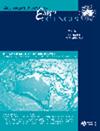Calcareous-nannofossil biostratigraphy of the Miocene Fatha Formation at the Miryas section, Qaradagh Mountain Series, Sulaimaniyah, Kurdistan Region, Iraq
IF 0.9
4区 地球科学
Q3 GEOSCIENCES, MULTIDISCIPLINARY
引用次数: 0
Abstract
Abstract The middle Miocene Fatha Formation is a prominent cap rock for hydrocarbon accumulations in Iraq’s oil fields. It is widely distributed in the Low Folded Zone but less common in the High Folded Zone of Iraq. For the first time, a nannostratigraphic study has been conducted on the formation at the Miryas locality in the High Folded Zone of the Qaradagh Mountain Series, southwest of Sulaimaniyah, Kurdistan Region, Iraq. The Fatha Formation consists of claystone, siltstone, marlstone, gypsum and few limestone beds. Ten samples were taken from marl-rich strata in the upper part of the formation between the red claystones of the Miryas. On the basis of the identified calcareous nannofossils, three biozones are recorded from the upper part of the Fatha Formation: the NN1, NN2 and NN3 zones. The combined stratigraphic ranges of the calcareous nannofossils identified here support the early Miocene–Aquitanian age; Discoaster druggii, Sphenolithus belemnos, S. cometa, S. procerus, S. tintinnabulum, S. delphix and S. capricornutus are marker species of the Aquitanian that have been identified inside the Miryas’s smear slides. These genera/species are also accompanied by the occurrences of Sphenolithus moriformis, Cyclicargolithus floridanus, Reticulofenestra minuta, R. bisecta, S. minuta, S. dictyoda, Coccolithus pelagicus, Helicosphaera carteri and Coronocyclus nitescens. The appearance of Discoaster saundersi at the top of the formation indicates the last occurrence of the NN2 zone of the Aquitanian and first occurrence of the NN3 zone of the Burdigalian. Through this study, for the first time, the early Miocene biozones determined within the Fatha Formation indicate that lower Miocene sediments (facies) were not deposited at some locations in the Qaradagh Mountain Series. Instead, the equivalent cap rock sediments of the Fatha Formation were deposited in the High Folded Zone; this clarifies why accumulation of hydrocarbons is rare within the late Oligocene–earliest Miocene succession in the High Folded Zone rather than the reservoir rocks of the same age in the Low Folded Zone (such as Kirkuk Oil Fields). KEY POINTS First study of nannostratigraphy of the Fatha Formation in the High Folded Zone of Iraq. First study of early Miocene nanno-biozones within the Fatha Formation. First record of NN1, NN2 and NN3 zones within the Fatha Formation.伊拉克库尔德斯坦地区苏莱曼尼亚Qaradagh山脉Miryas段中新世Fatha组钙质超微化石生物地层学
本文章由计算机程序翻译,如有差异,请以英文原文为准。
求助全文
约1分钟内获得全文
求助全文
来源期刊

Australian Journal of Earth Sciences
地学-地球科学综合
CiteScore
2.80
自引率
8.30%
发文量
45
审稿时长
6-12 weeks
期刊介绍:
Australian Journal of Earth Sciences publishes peer-reviewed research papers as well as significant review articles of general interest to geoscientists. The Journal covers the whole field of earth science including basin studies, regional geophysical studies and metallogeny. There is usually a thematic issue each year featuring a selection of papers on a particular area of earth science. Shorter papers are encouraged and are given priority in publication. Critical discussion of recently published papers is also encouraged.
 求助内容:
求助内容: 应助结果提醒方式:
应助结果提醒方式:


